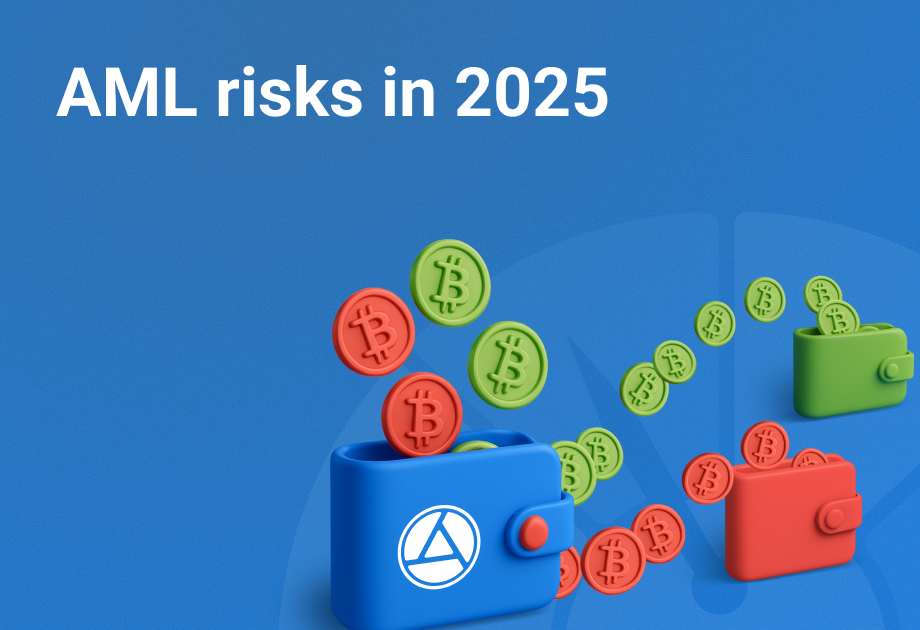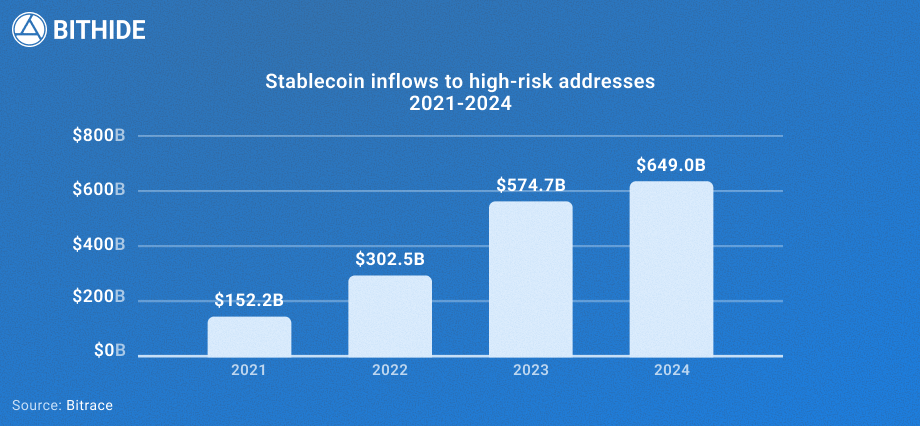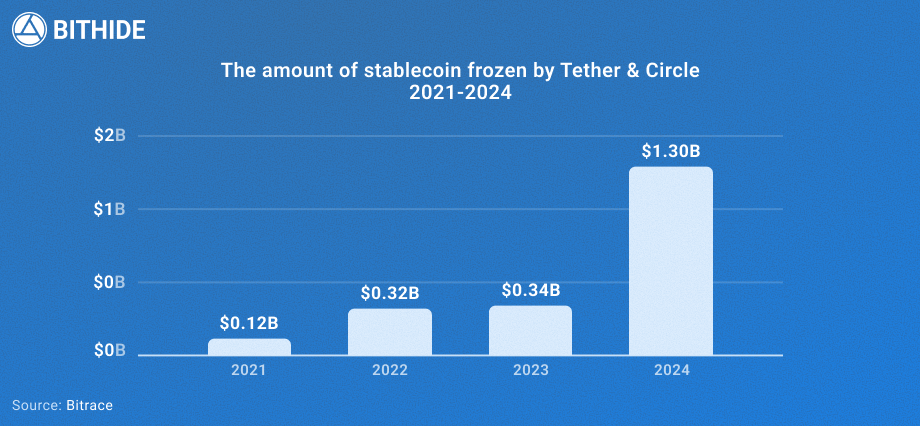All About Crypto AML Checks in 2025
1 in every 20 stablecoin transactions is suspicious. Here’s how to shield your business from AML risks.

The year 2024 was a landmark for the entire crypto industry: Bitcoin’s price surpassed $100,000 for the first time, and the total crypto market capitalisation hit $3.6 trillion. However, as popularity grew, so did the number of threats — for both everyday users and businesses. In 2024 alone, over $2 billion in crypto assets were stolen. More than $40.9 billion was linked to addresses involved in illicit activity.
Additionally, researchers at Bitrace published an analytical report showing that 5% of all stablecoin transactions — over $649 billion — involved suspicious addresses.

In this article, we explore AML risks 2025, why “dirty” crypto can pose a serious threat to your business, how to protect business from AML, and which tools help reduce exposure to frozen funds and regulatory scrutiny.
AML Risks: More Transparency, But the Threats Remain
In 2025, the crypto market continues to evolve. Regulators are intensifying efforts against money laundering, and transaction-monitoring tools like Chainalysis and Crystal now cover nearly the entire market — tracing activity, linking addresses and flagging high-risk behaviour.
Despite increasing transparency, crypto remains widely used in semi-legal and criminal schemes. Stablecoins in particular, once viewed as safe and “clean”, are now under closer scrutiny. In realit, 1 in every 20 stablecoin transactions is associated with suspicious addresses.
This poses serious concerns for AML compliance for businesses in 2025, especially in the broader context of KYC and AML compliance:
- It’s easy to unknowingly receive “dirty”funds.
- Just one high-risk transaction could lead to frozen assets.
- Stablecoin issuers may freeze assets with suspicious histories.

In 2024, Tether and Circle froze more than $1.3 billion worth of stablecoins on the Ethereum and TRON blockchains — twice as much as had been frozen across the previous three years combined. This reflects a tightening of AML regulations 2025 and the urgent need for robust protection.
Which Businesses Are Most Exposed to AML Risk
Companies with large crypto transaction volumes — particularly in fintech, gaming, e-commerce and DeFi — face heightened exposure simply due to transaction scale. Even with no illegal intent, receiving or handling risky assets can lead to frozen funds, halted operations and reputational damage. These sectors are also increasingly targeted in regulatory initiatives focused on financial crime prevention, making compliance not just a best practice but a necessity.
Case Study: How a Legitimate Business Had Its Funds Frozen
In 2024, an unnamed company (not disclosed publicly) received ETH from a client in Asia. One month later, Gemini exchange froze its account, citing exposure to a Tornado Cash-linked address, a mixer under US sanctions.
Even though the company was unaware of the origin of the funds and had no involvement in any legal activity, the exchange flagged the transaction as high-risk due to its connection with a sanctioned address.
As a result, the business lost access to over $100,000. After six months of administrative back-and-forth, only part of the funds was recovered. The rest remained frozen, as the Asian client refused to cooperate or provide documentation on the source of funds.
This highlights how easily AML risk assessment can be overlooked. Many businesses still:
- Do not monitor incoming crypto.
- Skip AML screening entirely.
- Rely on manual or outdated processes.
In 2025, ignoring business AML requirements is no longer an option. Below, we outline a practical AML compliance check list for crypto-facing companies.
What Companies Should Be Doing Now
As suspicious activity increases, so do fund freezes. For businesses processing hundreds or thousands of transactions daily, the risk of freeze grows by the day. To stay compliant and operational, businesses should:
- Check all incoming transactions. Even transfers in stablecoins like USDT or USDC can carry high AML risk — one in every twenty is linked to suspicious addresses.
- Use AML tools at every stage. Check not only the crypto assets you receive but also the addresses they come from. Analyze the origin and transaction history to assess risk levels in advance.
- Segment incoming funds. Don’t mix clean and risky — store and manage them separately using different wallets or addresses.
- Set up internal guidelines. Establish limits, trigger-based alerts, and clear protocols in case suspicious assests are receieved.
- Use transparent and customizable crypto solutions. For example, the BitHide wallet helps automate AML checks and separate high-risk crypto from safe assets.
Leading AML Screening Services
Where possible, companies should implement AML monitoring tools as part of an integrated approach to financial crime prevention. Regular screening is no longer enough — real-time automation is key to staying ahead of emerging threats. Here are the top blockchain analytics services that help with anti-money laundering 2025 initiatives and compliance frameworks:
| Service | Features | Best For |
| Chainalysis | In-depth blockchain analysis, clustering, KYT alerts | Corporates, regulators |
| Crystal | Transaction graphs, risk scoring, live monitoring | Fintechs, compliance teams |
| Bitrace | Stablecoin analytics, AML scoring, geo-risk analysis | Platforms dealing with USDT/USDC |
| Elliptic | Sanction screening, multichain support, intelligence | Banks, legal teams, financial institutions |
| Scorechain | Address classification, audit reporting, risk scores | Custodians, crypto service providers |
Each of these solutions qualifies as anti-money laundering software, though many require additional time and effort for post-check processing and fund segregation. For daily operations, a more practical solution is a crypto wallet or crypto processing with embedded AML tools.
Automating AML Processes for Crypto Businesses
Modern crypto processing platforms now offer built-in compliance capabilities. For example, BitHide’s wallet features a native AML check that evaluates both received crypto and sender addresses before a transaction is confirmed. If a risk is detected, the business can proactively request an alternative asset or wallet.
BitHide also offers automated AML monitoring tools for all incoming transfers, with assets sorted by risk level: clean funds go to one address, risky funds to another. Companies can define their own thresholds, in line with internal policies for KYC and AML compliance. This functionality dramatically reduces the chance of receiving tainted funds and the resulting disruption — a vital tool for firms prioritising financial crime prevention.
Curious how it works in practice? A major iGaming company has been using BitHide for six months without a single freeze.
Conclusion
The crypto market is still growing fast. In May 2025, Bitcoin once again crossed the $100,000 mark, and more companies are adopting crypto payments. Mastercard, for instance, has launched support for USDC and USDP payments.
As the industry expands, so do on-chain analytics infrastructure and AML regulations 2025. Mandatory AML screening is becoming the norm — and a single suspicious transaction could result in frozen funds, with no guarantee of recovery.
There are two paths forward: use standalone services like Chainalysis and Crystal, or adopt crypto wallets and payment gateways with built-in anti-money laundering software. At BitHide, we offer the latter: real-time risk scoring, full pre-transfer screening, smart asset separation, and custom rule-setting — all under your control.
If you need a solution for AML compliance for businesses without sacrificing privacy or flexibility, get in touch with our team. We’ll help you find a right solution tailored to your needs.

